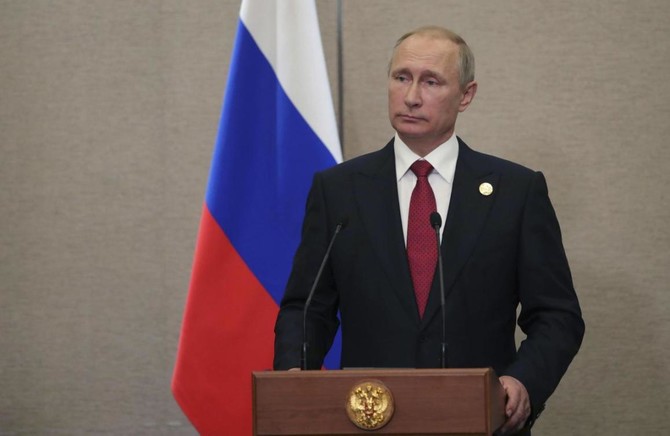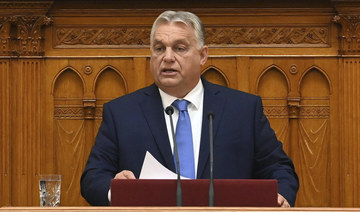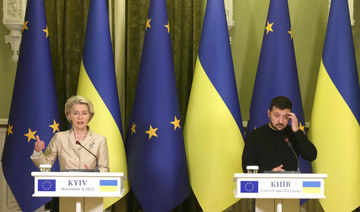XIAMEN, China: Russia reserves the right to further cut the number of US diplomatic staff in Moscow, Russian President Vladimir Putin said on Tuesday, in response to what he called Washington’s “boorish” treatment of Russia’s diplomatic mission on US soil.
Speaking after US officials ordered Russia to vacate diplomatic premises in several US cities, Putin said he would order the Russian foreign ministry to take the US authorities to court over alleged violations of Russia’s property rights.
“That the Americans reduced the number of our diplomatic facilities — this is their right,” Putin told a news conference in the Chinese city of Xiamen, where he was attending a summit of BRICs nations.
“The only thing is that it was done in such a clearly boorish manner. That does not reflect well on our American partners. But it’s difficult to conduct a dialogue with people who confuse Austria and Australia. Nothing can be done about it. Probably such is the level of political culture of a certain part of the US establishment.”
“As for our buildings and facilities, this is an unprecedented thing,” Putin said. “This is a clear violation of Russia’s property rights. Therefore, for a start, I will order the Foreign Ministry to go to court — and let’s see just how efficient the much-praised US judiciary is.”
The US order for Russia to vacate some of its diplomatic properties was the latest in a series of tit-for-tat actions that began when former US President Barack Obama, late last year, expelled 35 Russian diplomats.
The Obama administration said it was retaliating for Russian meddling in the US presidential election, an allegation that Moscow has denied.
In July, Moscow responded, ordering the United States to cut the number of its diplomatic and technical staff working in Russia by around 60 percent, to 455.
Moscow said the move aimed to bring the number of US and Russian diplomats working on each other’s soil to parity.
But Putin said that the latest expulsions ordered by Washington bring the number of Russian diplomats on US soil to below parity.
He said that the United States was erroneously counting 155 Russian diplomats working at the United Nations headquarters in New York as being Russian diplomats on US soil. If they are removed from the equation, Putin said, Russia has fewer than 455 diplomats in the United States.
“We reserve the right to take a decision on the number of US diplomats in Moscow. But we won’t do that for now. Let’s wait and see how the situation develops further,” he told the news conference.
The United States has ordered the closure of the Russian consulate in San Francisco and two buildings housing trade missions in Washington and New York.
US President Donald Trump took office in January, saying he wanted to improve ties with Russia. But relations have been damaged by accusations from US intelligence officials that Russia sought to meddle in the presidential election.
US-Russian relations have also been badly strained since Moscow’s annexation of Crimea in 2014 and the subsequent separatist conflict in eastern Ukraine, developments which led Washington to impose sanctions on Russia.
Trump, himself battling allegations his associates colluded with Russia, grudgingly signed into law new sanctions against Moscow that had been drawn up by Congress.
Putin: Russia reserves right to further cut US diplomatic mission
Putin: Russia reserves right to further cut US diplomatic mission

Russian court fines man for hair dyed in colors of Ukrainian flag, OVD-Info says
Netesov was found guilty of discrediting the armed forces on May 3, an online court notice shows, although it does not specify a fine
LONDON: A Russian man who had his hair dyed in some of the colors of the Ukrainian flag has been fined 30,000 roubles ($330) by a court for “discrediting” the Russian army, rights group OVD-Info reported on Monday.
Photographs of Stanislav Netesov posted online show the 25-year-old’s close-cropped hair colored bright blue, green and yellow. Blue and yellow are the colors of the Ukrainian flag.
More than 20,000 people have been detained for their anti-war stance since the start of Moscow’s full-scale invasion of Ukraine in February 2022, with over 900 people charged with criminal offenses.
Netesov was found guilty of discrediting the armed forces on May 3, an online court notice shows, although it does not specify a fine.
In court, Netesov denied his hair color was meant as a statement of protest, saying that he does not support either Ukraine or the Russian army, independent news outlet Mediazona reported. He said he has dyed his hair bright colors for years.
Netesov could not be reached for comment.
The case against the Muscovite began in late April, when he was attacked by unknown people while returning home from work late at night.
The assailants stole his mobile phone and knocked out one of his teeth, Netesov told OVD-Info, which assists those targeted for opposing the war.
When he went to the police to file a report, officers noticed his hair and charged him under the “discrediting” statute, Mediazona reported.
“The aforementioned visual propaganda clearly expressed a negative attitude toward the Armed Forces of the Russian Federation,” Mediazona cited the police report as saying.
Officers also gave Netesov a summons to report to a military enlistment office. He then revealed to them he was a transgender man, after which they canceled the summons, Mediazona said.
A Russian man who had his hair dyed in some of the colors of the Ukrainian flag has been fined 30,000 roubles ($330) by a court for “discrediting” the Russian army, rights group OVD-Info reported on Monday. (X/@JPNWMN)
Gunmen kill around 40 people in attack in northcentral Nigeria: official

- Armed men invaded Zurak community, shooting sporadically and torching houses
- Local youth leader Shafi’i Sambo also said at least 42 people had been killed in the raid
LAGOS: Gunmen riding motorbikes killed around 40 people in a raid on a mining community in northcentral Nigeria, opening fire on residents and torching homes, the local government said on Tuesday.
The attack late on Monday on Wase district in Plateau state was the latest violence in an area which has long been a flashpoint for disputes over resources and for outbreaks of intercommunal clashes.
Armed men invaded Zurak community, shooting sporadically and torching houses, Plateau state commissioner for information Musa Ibrahim Ashoms told AFP by telephone.
“As we speak, about 40 people have been confirmed dead. Zurak is a popular mining community,” he said.
Local youth leader Shafi’i Sambo also said at least 42 people had been killed in the raid.
Wase has deposits of zinc and lead, while Plateau as a whole is known for its tin mining industry.
Sitting on the dividing line between Nigeria’s mostly Muslim north and predominantly Christian south, Plateau often sees outbreaks of violence sparked by disputes between nomadic herders and pastoral farmers.
Climate change has also helped escalate tensions over grazing land, water access and other resources such as the state’s metal reserves.
Parts of northwest and northcentral Nigeria have also been terrorized by heavily armed criminal gangs, who raid villages to loot and carry out mass kidnappings for ransom.
In January, intercommunal clashes erupted in Plateau’s Mangu town that left churches and mosques burned, more than 50 people dead and thousands displaced.
Over 3,000 Ukrainian inmates seek to join military

- Ukraine is suffering critical ammunition and manpower shortages on the battlefield
- “We predicted this before the adoption of this law,” Deputy Minister of Justice Olena Vysotska said
KYIV: Thousands of Ukrainian inmates are seeking to join the military, Kyiv said Tuesday, following a decision by lawmakers enabling some categories of prisoners to join the armed forces.
The move echoes a policy in Russia, where tens of thousands of prisoners have been sent to Ukraine with the promise of amnesty and were killed in gruelling battles that produced few gains.
Ukraine is suffering critical ammunition and manpower shortages on the battlefield that have allowed Russian forces to advance on the eastern and northern front lines.
“This is more than 3,000 people. We predicted this before the adoption of this law,” Deputy Minister of Justice Olena Vysotska said, referring to the number of prisoners who have submitted applications to join the military.
She said authorities had identified 20,000 eligible prisoners and that of them, 4,500 had “expressed interest” in joining. She added that the figure was likely to fluctuate.
Only prisoners with fewer than three years left on their sentence can apply. Mobilized prisoners are granted parole rather than a pardon.
Among those not eligible to serve include those found guilty of sexual violence, killing two or more people, serious corruption and former high-ranking officials.
Russia has recruited prisoners to serve on the front lines since the first days of its invasion, initially offering presidential pardons for six months’ service.
EU states push for June start to Ukraine membership talks

- To actually begin the negotiations the bloc’s member states still have to sign off on a formal framework for the process
- At a meeting in Brussels, France’s EU affairs minister Jean-Noel Barrot called for “the effective opening of negotiations“
BRUSSELS: Several EU countries on Tuesday called for the bloc to start membership negotiations with Ukraine and Moldova in June, but Hungary threatened to throw a spanner in the works.
The 27-nation EU took the landmark step in December of agreeing to open talks on its war-torn neighbor — and fellow ex-Soviet state Moldova — joining the club.
But to actually begin the negotiations the bloc’s member states still have to sign off on a formal framework for the process, proposed in March by Brussels.
At a meeting in Brussels, France’s EU affairs minister Jean-Noel Barrot called for “the effective opening of negotiations” before Belgium’s rotating presidency concludes at the end of June.
That statement was echoed by other ministers — including from Ireland and Sweden.
The push to move Ukraine onto the next step in its quest for EU membership comes amid fears that Hungary, the friendliest country with Moscow in the bloc, could stall progress when it takes over the presidency after Belgium.
Budapest has been hostile to Kyiv’s bid to join, arguing that Ukraine is getting pushed ahead in the queue without meeting the required criteria.
“There can be no exception on the basis of political or ideological considerations,” Hungarian minister Zoltan Kovacs said.
“There is very little, if any, progress. Again, I can repeat to you that membership, approval should be a merit based process. No exceptions.”
Another possible hurdle could come from a new right-wing government being formed in The Netherlands opposed to any new enlargement of the bloc.
Ukraine applied to join the EU shortly after Russia launched all-out invasion in February 2022.
Starting the negotiations would put Ukraine still only at the start of what is likely to be a years-long process of reforms before it can finally become a member.
Philippine island boasts world’s largest concentration of unique mammals

- 93% of mammals in Luzon are found nowhere else
- Island has higher biological diversity than Galapagos
MANILA: Luzon may be known as the largest and most populous island of the Philippines, but it is also home to the greatest concentration of unique mammal species on Earth. Most of them are found nowhere else in the world.
The island, where the Philippine capital Manila is located, had never been connected to any continental land. Throughout the ages, this allowed the species that arrived there from the Asian mainland to evolve, diversify, and thrive in different habitats of its mountain ranges and peaks isolated by lowlands.
It is also one of the oldest islands, with geological research indicating that parts of it have been dry land areas continuously for some 27 million years.
“It’s a really old island. So, there’s time for rare events to take place. That’s a big part of it,” Dr. Lawrence Heaney, biologist and curator of mammals at the Field Museum in Chicago, told Arab News.
“There are no countries in continental Europe that have (this number of) unique species of mammals.”
Heaney is one of the first researchers to document the island’s diversity and has been leading American and Filipino scientists studying mammals in the Philippines since 1981.
His team’s 15-year study, which started in 2000, concluded that there were 56 species of mammals — not including bats — on the island, and 52 of them were endemic.
This means that 93 percent of Luzon’s non-flying mammals are found nowhere else, making it a biological treasure trove.
Luzon beats even the Galapagos islands, where each has been known for its diverse and unique array of wildlife.
“Luzon takes it another step further because there are isolated mountain ranges and isolated mountain peaks that are separated from all others by lowlands. They function as islands. Islands in the sky. Each one of those islands in the sky has its own unique set of species. Luzon island is made up of islands within the island,” Heaney said.
“What’s in the northern Sierra Madre, you know Cagayan province ... is very different from what’s in the mountains that are in Aurora province, because there’s an area of lowlands that separates those two different mountain chains. Then the mountains, the next set of mountains down also are separated by another low-lying area ... There are species of mammals that occur there that don’t live anywhere else in the world.”
Many of those mammals are tiny — the size of the house mouse. When most people think about mammal species, they usually imagine those on the larger part of the spectrum, like themselves.
“We think about water buffalo and horses and lions and tigers and bears,” Heaney said. “There are actually very few large mammals, overwhelmingly, most mammals are small, less than 200 grams ... Not surprisingly, given that, most of the things that we have discovered that were previously unknown are small.”
Mariano Roy Duya, associate professor at the University of the Philippines’ Institute of Biology, who has been working with Heaney, told Arab News that 28 out of the 56 mammal species identified in Luzon were rodents.
Two of them — the Banahaw shrew rat and the Banahaw tree mouse — were endemic to Mt. Banahaw, which is only 100 km from Manila.
The Banahaw shrew-rat has a long, slender snout, a short tail, and weighs 150 grams, while the Banahaw tree mouse is the smallest member of the cloud rat family at 15.5 grams, and navigates tree branches and vines.
Their habitat is now protected due to the efforts of the Biodiversity Conservation Society of the Philippines, a group that was created thanks to the work of scientists like Heaney and Duya, who now serves as its vice president.
The society is an organization that the Philippine Department of Environment and Natural Resources consults on the country’s conservation efforts.
Some 20 percent of the species Heaney, Duya, and other researchers studied during their long Luzon project are vulnerable, endangered, or critically endangered due to habitat loss, hunting, and illegal wildlife trade.
“(These include) deer, warty pigs, cloud rats, flying foxes, cave-dwelling bats, and civets,” Duya said.
“According to the hunters we meet in the forest, these animals are becoming hard to find.”
Most of the threats to Luzon’s wildlife were observed in lowland forests, which are usually lost to human development, overlogging, conversion to agricultural fields, and trafficking.
“Close monitoring of illegal wildlife trade and regular enforcement activities should be a priority,” Duya said.
“Securing these forests, as well as forest fragments, will provide refuge to many of these endemic faunae.”
















